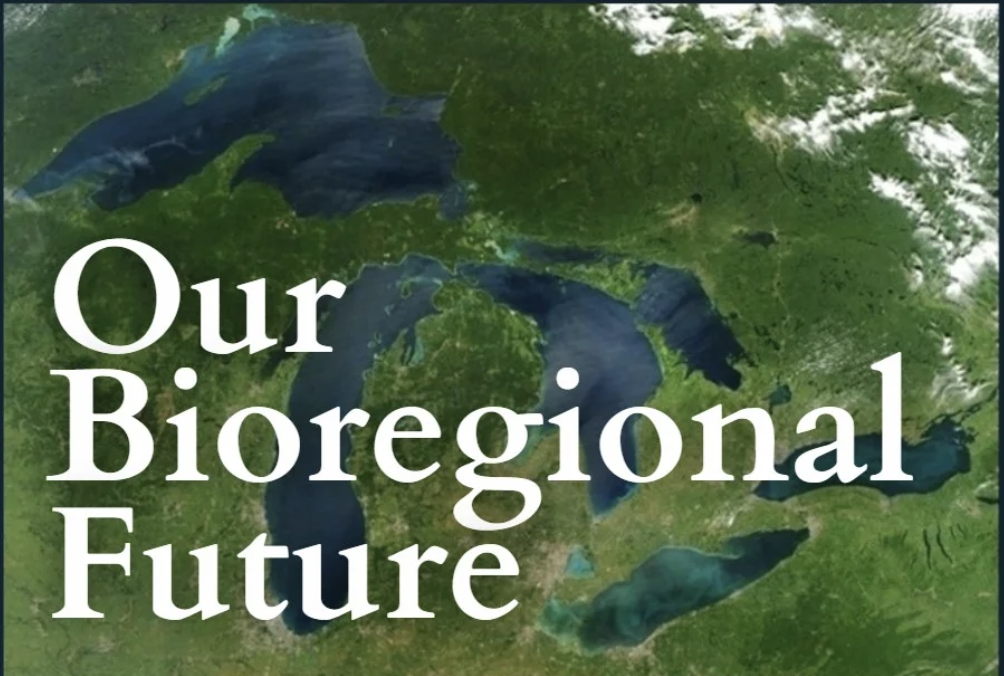Our Bioregional Future

Reprinted from the Pachamama Alliance of the Rochester Area’s Newsletter (April 2023)
By Jonathan Cloud
Bioregionalism is not a new idea. Arguably, all civilizations prior to our own have lived bioregionally, adapting themselves to local conditions and trading within a limited biogeographic region. Modern civilization, however, as the first to “go global,” has created extensive and often fragile supply chains in an effort to maximize profit. Modern nation-states are also bounded by political geography, as a result of wars, conquest, and colonization. These factors have created limitations on our ability to make environmentally sustainable, socially just, and spiritually fulfilling decisions.
“Bioregionalism” as a term emerged in the 1970s, referring to “a philosophy that suggests that political, cultural, and economic systems are more sustainable and just if they are organized around naturally defined areas called bioregions, similar to ecoregions.” More specifically, though, it is not just a philosophy that things might be better this way; it’s also a recipe for taking practical action to restore the health and vitality of our bioregions. It is through this action that we come together.
Some people may question whether this is necessary in the case of the Great Lakes region. Compared with many other regions, ours appears to be something of a verdant paradise — 20% of the world’s freshwater, unparalleled opportunities for boating, fishing, and other recreation, etc. But this is looking at the surface only. The fact is that most of the water remains badly polluted; the cities around the lakes, especially on the American side, are struggling with decay, industrial decline, and decades of mismanagement. And despite many wonderful vineyards and apple farms, much of the land around the lakes remains in conventional agriculture: laden with chemicals, exposed soils, and used for monocropping.
Moreover, as elsewhere, regenerative efforts are scattered and disconnected, impeded by multiple layers of bureaucracy, with landscapes desecrated by shopping malls, industrial parks, and commercial strips—the increasingly obsolete detritus of our consumptive civilization. What’s needed is a new approach, based on a different vision of what’s possible and what’s needed, informed by indigenous practices and regenerative stewardship, that leaves the landscape healthier, communities renewed, and a culture of care rather than exploitation.
Brandon Letsinger writes,
Bioregionalism is a vision of a future that works for people and for the Earth.
For the majority of human history, people have lived bioregionally.
Bioregionalism is a movement, an ethic, and an idea that has been growing for more than four decades which seeks to do just that, by using natural features such as mountain ranges, and rivers as the basis for political and cultural units, rather than arbitrary lines on a map. Using these features, it seeks to reign in extractive economic policies, create regenerative cultures that ensure ethical, local, and sustainable means of production, and reconnect the livelihood of inhabitants within the limits of place.
At its roots, Letsinger argues, bioregionalism “is a way to restructure society to work within each given region and place, rather than transforming each to human needs.”
Bioregionalism can provide communities with greater resilience and self-sufficiency in the face of climate disruption and biodiversity loss. Bioregionalism can also renew a sense of place and of our embeddedness in biological systems that are capable of healing if we are willing to allow them to do so. Bioregionalism can also bring about a cultural and spiritual transformation—again, if we’re willing to allow it—that stresses our deep interdependence with the rest of life.
This vision only appears radical because it is so thoroughly contrary to the ways we’ve been taught to think and act toward “the dirt,” as simply a place that is ours to build on, to trample on, and to excavate in order to get to its treasures. Recent scientific findings suggest that Earth restoration can return watersheds to drinkable condition, revegetate and draw down CO2, and provide “nature-based solutions” to climate change. (See also Nature-Based Solutions And Carbon Dioxide Removal and Benefit Accounting of Nature-Based Solutions)
Indeed, restoring somewhere between 30% and 50% of the accessible land area could possibly counteract the impact of increased greenhouse gases just through organic uptake alone. This is the way the Earth system actually works, balancing the elements that make the atmosphere breathable and comfortable in order to keep it in the Goldilocks zone. This was central to James Lovelock’s “Gaia hypothesis,” that the Earth self-regulates, and seeks to maintain a dynamic equilibrium that is conducive to life as we know it. Janine Benyus has brought [this] central lesson of a regenerative culture to the point: “Life creates conditions conducive to life.” And it is literally true, as plant life supports animal life, and animal life supports the bacterial world in turn.
Kirkpatrick Sale, who grew up near Ithaca and became the foremost expositor of bioregionalism in the 1990s, wrote at the time:
To become dwellers in the land, to relearn the laws of Gaea, to come to know the earth fully and honestly, the crucial and perhaps only and all-encompassing task is to understand place, the immediate specific place where we live. The kinds of soils and rocks under our feet; the source of the waters we drink; the meaning of the different kinds of wind; the common insects, birds, mammals, plants, and trees; the times to plant and harvest and forage—these are the things that are necessary to know. The limits of its resources; the carrying capacities of its lands and waters; the places where it must not be stressed; the places where its bounties can best be developed; the treasures it holds and the treasures it withholds—these are the things that must be understood. And the cultures of the people, of the populations native to the land and those who have grown up with it, the human social and economic relationships shaped by and adapted to the geomorphic ones in both urban and rural settings—these are the things that must be appreciated.
That, in essence, is bioregionalism.
(Kirkpatrick Sale, Dwellers in the Land, 1991, p.42)
Bioregionalism, writes Benji Ross thirty years later, is an idea whose time has come.
There is something significant to note about the few examples that I’ve seen of people beginning to host bioregional conversations and to form bioregional groups. Simply put, this wants to happen. It seems that all that is needed is the right spaces and conditions in place. The time is ripe for bioregionalism to unfold.
Put another way, there is a growing desire to reorient and reorganize cultures and economies to be patterned on holistic landscape functions. It’s as if the poor health of local land and ecology are crying out and more people each day are learning to listen. For that growing number, the level of grief throughout the landscape is impossible to bear. The dysfunctions of current systems are becoming harder to ignore and it’s the many negative impacts on the Earth that are tipping us towards a major transition. All that is needed is a story that offers a sensible, feasible, and integrated alternative along with a pathway to get us there.
(Benji Ross, Great Lakes Basin Bioregional Conversations: Modeling a Pattern of Bioregional Activation, 2023)
This desire to re-orient and reorganize was clearly manifested in our recent hosting of Joe Brewer and Penny Heiple in Rochester (February 10-12, 2023). I was initially unsure whether there would be any interest in bringing up the bioregional perspective, but it was immediately apparent that there was a deep desire for this kind of conversation—perhaps as an alternative to denialism, and also as a way to take practical action to restore the health of ecosystems where we live.
Observing it from afar, Benji Ross expressed the following:
Inviting them was an opportunity to create coherence and coordination across all of the communities that are part of the upcoming tour. What has emerged however is a group of people forming a sort of consciousness of the Great Lakes as an integrated whole, enthusiastically and more or less prosocially exploring ways that this way of organizing and a regional narrative can grow.
Joe Brewer’s book, Design Pathway for Regenerating Earth (2021) provides the “cultural scaffolding” we need, in order to recognize the importance of creating a global network of bioregional learning centers—think and do centers, ecoversities, and bioregional councils that can learn and evolve together to create a regenerated Earth. As Joe says,
There needs to be a clear set of mechanisms to re-invest the wealth taken from the Earth during prior times of extraction. These mechanisms need to enable landscapes to be regenerated as millions of us live through the extremely difficult period of overshoot-and-collapse of the dominant extractive economy. People will need (a) land to live on; while (b) participating in economic exchanges that maintain their wellbeing; so that (c) they can engage in regenerative practices for their landscapes that are (d) long-term and future oriented.
We should not be discouraged by the extraordinary scale of this challenge. It represents an open field of opportunity for regenerative practitioners, especially those who focus on weaving a tapestry of others’ efforts into a coherent pattern for a bioregion as a whole. Not everyone needs to be pulling invasive grasses and rebuilding the soil all of the time; it’s equally if not more important to create the opportunity for others to fulfill their callings in service to the Earth.
One structure to support these efforts, offered by Brewer, Ross, and Heiple, is the Design School for Regenerating Earth, whose “[M]embers are working together on the ground in bioregions while simultaneously building a planetary network and community engaging in this kind of bioregional work. … and enabl[ing] focused actions to arise with clear design and intent so that we can effectively regenerate at the bioregional scale and create interactions and supports between and across bioregions.”
A further description of the School, including costs and scholarship opportunities, is available on the website and described in Joe’s recent article on Medium:
People all over the world are gathering to learn how to restore landscapes, collaborate to achieve systemic outcomes, and work together in service to safeguarding our planetary future.
…We can organize ourselves around holistic, integrated landscapes known as bioregions. Create prosocial groups that know how to work toward shared goals. And weave across features of landscapes to collaborate at continental and planetary scales.
… Our focus is the regeneration of entire bioregions. Most of the work will be to organize and support on-the-ground efforts as we grow into a planetary network of learning exchanges.
It is not difficult to see in these efforts and the philosophy of bioregionalism the outlines of a new society. Buckminster Fuller argued that rather than fighting the old model (which at some level is already falling apart) we should instead focus on building a new model that people will flock to instead. I have no doubt that this model will be bioregional and that ultimately bioregional considerations will outweigh narrowly economic and political ones.
Convening these conversations has been, as Benji Ross writes, “the impetus for new connections, and an early exploration into a shared regional narrative. The potential for this to mature into something more is clearly apparent.” Indeed, part of what was surprising was that there were many others of like mind, including many residing in the same area, who somehow had not met over the years, but who were just now connecting. Exchanges like these can prove to be transformative. If we acknowledge the significance of bioregionalism, it has the potential to open up a new realm of possibility and create extraordinary change.
The future we’re looking for, as the Pachamama Alliance says, is socially just, environmentally sustainable, and spiritually fulfilling. Bioregionalism is one of the first steps along that pathway. And if we’re wrong about the impact of increasing biodiversity on the climate crisis? I guess, as an old climate cartoon suggests, we will have created a better world for nothing.
